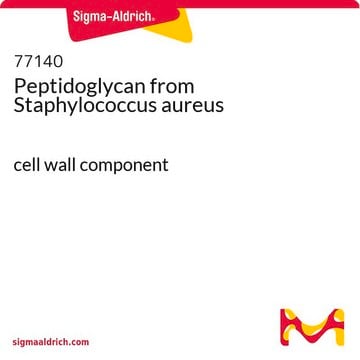L4015
Lipoteichoic acid from Enterococcus hirae
Se connecterpour consulter vos tarifs contractuels et ceux de votre entreprise/organisme
About This Item
Produits recommandés
Source biologique
bacterial (Enterococcus hirae)
Niveau de qualité
Forme
lyophilized powder
Conditions d'expédition
ambient
Température de stockage
2-8°C
Description générale
the bacterial source Streptococcus faecalis has been renamed Enterococcus hirae
Actions biochimiques/physiologiques
Lipoteichoic acid (LTA) is a complex component of cell walls of Gram-positive bacteria that are involved in a wide range of cell processes such as the stimulation of immune responses and cell signaling pathways. LTA differs between species of gram-positive bacteria. Lipoteichoic acid from Streptococcus faecalis may be used to compare its structure, immunogenicity and functions versus other bacterial LTAs.
Code de la classe de stockage
11 - Combustible Solids
Classe de danger pour l'eau (WGK)
WGK 3
Point d'éclair (°F)
Not applicable
Point d'éclair (°C)
Not applicable
Équipement de protection individuelle
Eyeshields, Gloves, type N95 (US)
Certificats d'analyse (COA)
Recherchez un Certificats d'analyse (COA) en saisissant le numéro de lot du produit. Les numéros de lot figurent sur l'étiquette du produit après les mots "Lot" ou "Batch".
Déjà en possession de ce produit ?
Retrouvez la documentation relative aux produits que vous avez récemment achetés dans la Bibliothèque de documents.
Zdeněk Zídek et al.
Nitric oxide : biology and chemistry, 23(4), 300-310 (2010-09-21)
Lipoteichoic acid (LTA) is a structural component of the cell walls of Gram-positive bacteria. Similar to lipopolysaccharide (LPS) which is expressed in Gram-negative bacteria, LTA exhibits immunostimulatory properties. Frequently observed positive response of LTA in the Limulus amebocyte lysate (LAL)
G L Card et al.
Journal of leukocyte biology, 56(6), 723-728 (1994-12-01)
The relative activities of lipoteichoic acid (LTA) from four Gram-positive bacteria were compared to different lipopolysaccharide (LPS) preparations for activation of arachidonic acid metabolism in mouse peritoneal macrophages. Total eicosanoid was determined in cultures labeled with [3H]-arachidonic acid. Prostaglandin E2
Tetsuaki Ishikawa et al.
Cell host & microbe, 13(4), 477-488 (2013-04-23)
Various C-type lectin receptors (CLRs), including Mincle and Dectin-2, function as pattern recognition receptors and play a central role in immunity to fungal pathogens. However, the precise structures of the CLR ligands in various pathogenic fungi have yet to be
Anton Steen et al.
The Journal of biological chemistry, 278(26), 23874-23881 (2003-04-10)
The C-terminal region (cA) of the major autolysin AcmA of Lactococcus lactis contains three highly similar repeated regions of 45 amino acid residues (LysM domains), which are separated by nonhomologous sequences. The cA domain could be deleted without destroying the
Christoph Thiemermann
Microbes and infection, 4(9), 927-935 (2002-07-11)
The cell wall of Gram-positive bacteria contains lipoteichoic acid (LTA) and peptidoglycan (PepG), which synergise to cause shock and organ failure in animals, and to activate human blood to release proinflammatory cytokines. The structural elements within LTA and PepG that
Notre équipe de scientifiques dispose d'une expérience dans tous les secteurs de la recherche, notamment en sciences de la vie, science des matériaux, synthèse chimique, chromatographie, analyse et dans de nombreux autres domaines..
Contacter notre Service technique





